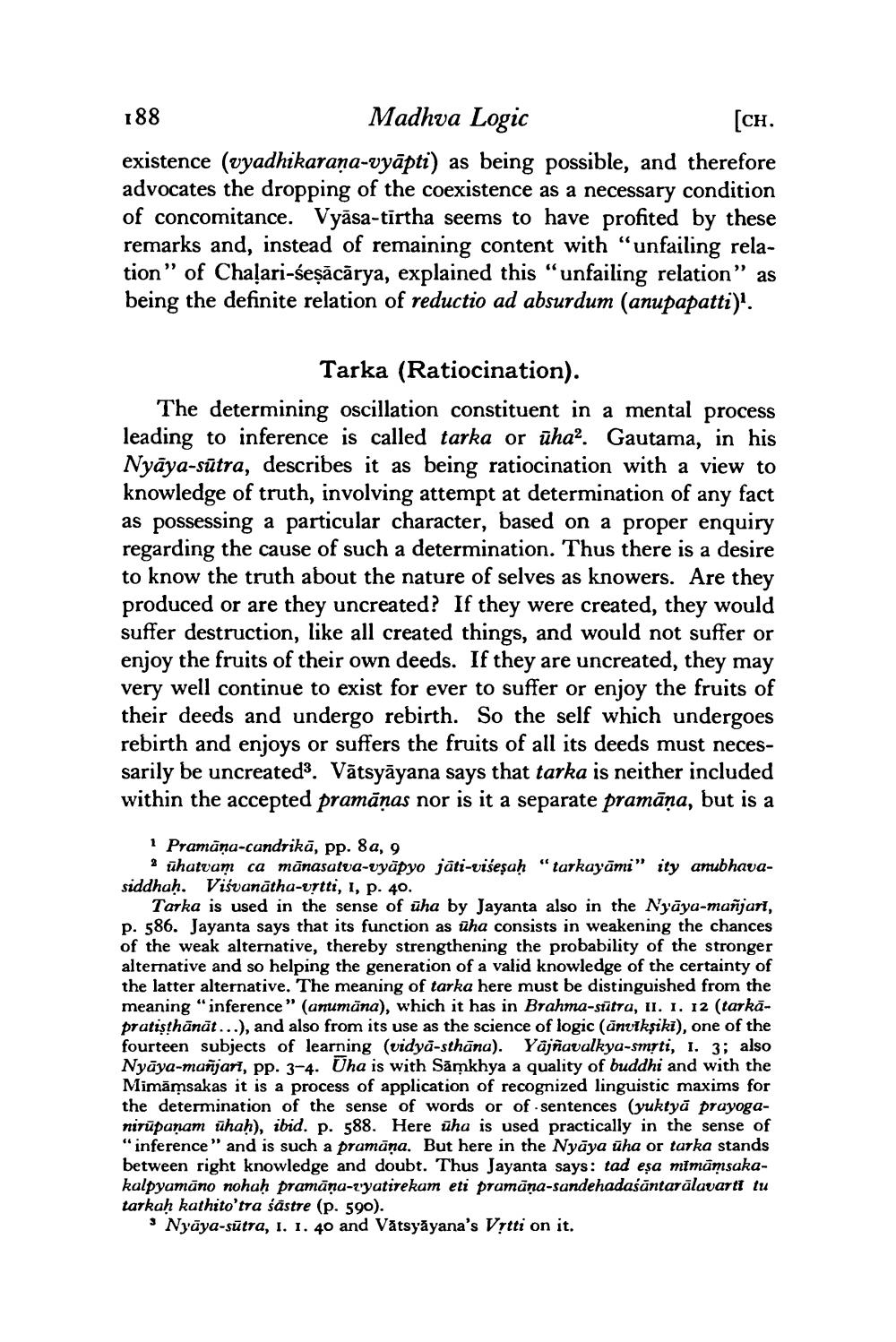________________
188 Madhva Logic
[CH. existence (vyadhikarana-vyāpti) as being possible, and therefore advocates the dropping of the coexistence as a necessary condition of concomitance. Vyāsa-tirtha seems to have profited by these remarks and, instead of remaining content with “unfailing relation" of Chaļari-śeşācārya, explained this “unfailing relation" as being the definite relation of reductio ad absurdum (anupapatti)".
Tarka (Ratiocination). The determining oscillation constituent in a mental process leading to inference is called tarka or ūha. Gautama, in his Nyāya-sūtra, describes it as being ratiocination with a view to knowledge of truth, involving attempt at determination of any fact as possessing a particular character, based on a proper enquiry regarding the cause of such a determination. Thus there is a desire to know the truth about the nature of selves as knowers. Are they produced or are they uncreated? If they were created, they would suffer destruction, like all created things, and would not suffer or enjoy the fruits of their own deeds. If they are uncreated, they may very well continue to exist for ever to suffer or enjoy the fruits of their deeds and undergo rebirth. So the self which undergoes rebirth and enjoys or suffers the fruits of all its deeds must necessarily be uncreated3. Võtsyāyana says that tarka is neither included within the accepted pramānas nor is it a separate pramāņa, but is a
1 Pramāna-candrikā, pp. 8a, 9
* ūhatvam ca mānasatva-vyāpyo jāti-višeșah "tarkayāmi" ity anubhavasiddhah. Visvanātha-urtti, 1, p. 40.
Tarka is used in the sense of üha by Jayanta also in the Nyāya-mañjari, p. 586. Jayanta says that its function as üha consists in weakening the chances of the weak alternative, thereby strengthening the probability of the stronger alternative and so helping the generation of a valid knowledge of the certainty of the latter alternative. The meaning of tarka here must be distinguished from the meaning "inference" (anumāna), which it has in Brahma-sūtra, II. I. 12 (tarkāpratisthānāt...), and also from its use as the science of logic (anviksiki), one of the fourteen subjects of learning (vidya-sthāna). Yajñavalkya-smrti, I. 3; also Nyāya-mañjart, pp. 3-4. Uha is with Samkhya a quality of buddhi and with the Mimāmsakas it is a process of application of recognized linguistic maxims for the determination of the sense of words or of sentences (yuktyā prayoganirūpanam ühah), ibid. p. 588. Here üha is used practically in the sense of "inference" and is such a prumāņa. But here in the Nyāya üha or tarka stands between right knowledge and doubt. Thus Jayanta says: tad eşa mimūmsakakalpyamāno nohah pramāna-ziyatirekam eti pramāna-sandehadaśāntarālavarti tu tarkaḥ kathito'tra sastre (p. 590).
* Nyāya-sūtra, I. 1. 40 and Vätsyāyana's Vịtti on it.




